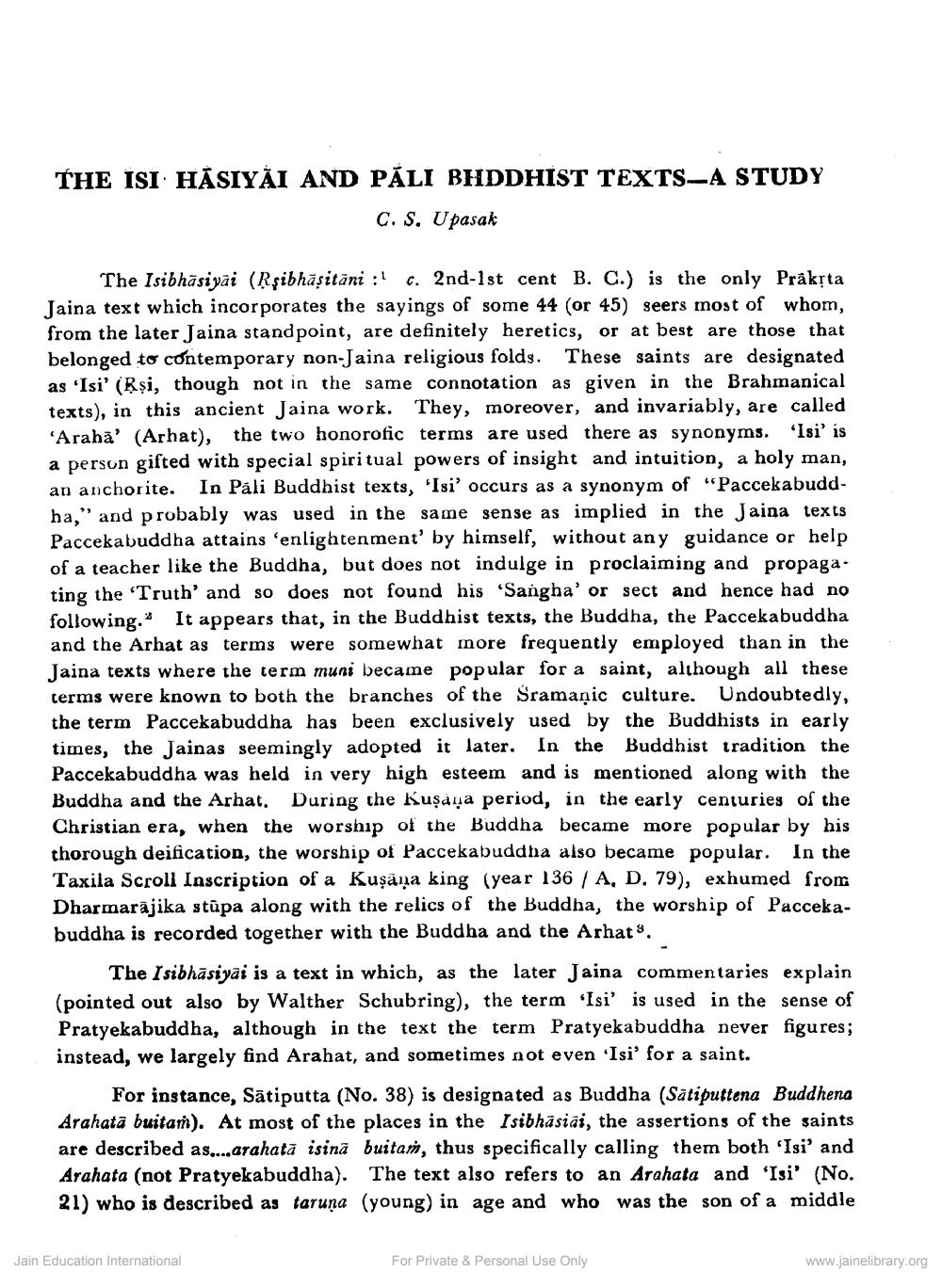Book Title: Isibhasiyai and Pali Buddhist Texts A Study Author(s): C S Upasak Publisher: Z_Aspect_of_Jainology_Part_3_Pundit_Dalsukh_Malvaniya_012017.pdf View full book textPage 1
________________ THE ISI HÁSIYAI AND PÁLI BHDDHIST TEXTS-A STUDY C. S. U pasak The Isibhāsiyai (Rşibhāṣitāni :1 c. 2nd-1st cent B. C.) is the only Praksta Jaina text which incorporates the sayings of some 44 (or 45) seers most of whom, from the later Jaina standpoint, are definitely heretics, or at best are those that belonged to contemporary non-Jaina religious folds. These saints are designated as 'Isi' (Rși, though not in the same connotation as given in the Brahmanical texts), in this ancient Jaina work. They, moreover, and invariably, are called 'Araha' (Arhat), the two honorofic terms are used there as synonyms. "Isi' is a person gifted with special spiritual powers of insight and intuition, a holy man, an anchorite. In Páli Buddhist texts, 'Isi' occurs as a synonym of “Paccekabuddha,” and probably was used in the same sense as implied in the Jaina texts Paccekabuddha attains enlightenment' by himself, without any guidance or help of a teacher like the Buddha, but does not indulge in proclaiming and propaga. ting the 'Truth' and so does not found his 'Sangha' or sect and hence had no following. It appears that, in the Buddhist texts, the Buddha, the Paccekabuddha and the Arhat as terms were somewhat more frequently employed than in the Jaina texts where the term muni became popular for a saint, although all these terms were known to both the branches of the Sramanic culture. Undoubtedly, the term Paccekabuddha has been exclusively used by the Buddhists in early times, the Jainas seemingly adopted it later. In the Buddhist tradition the Paccekabuddha was held in very high esteem and is mentioned along with the Buddha and the Arhat. During the Kuşaņa period, in the early centuries of the Christian era, when the worship of the Buddha became more popular by his thorough deification, the worship of Paccekabuddha also became popular. In the Taxila Scroll Inscription of a Kuşāņa king (year 136 / A, D, 79), exhumed from Dharmarājika stūpa along with the relics of the Buddha, the worship of Paccekabuddha is recorded together with the Buddha and the Arhat %. The I sibhāsiyai is a text in which, as the later Jaina commentaries explain (pointed out also by Walther Schubring), the term 'Isi' is used in the sense of Pratyekabuddha, although in the text the term Pratyekabuddha never figures; instead, we largely find Arahat, and sometimes not even 'Isi' for a saint. For instance, Sātiputta (No. 38) is designated as Buddha (Satiputtena Buddhena Arahata buitań). At most of the places in the Isibhāsiai, the assertions of the saints are described as....arahatā isinā buitan, thus specifically calling them both 'Isi' and Arahata (not Pratyekabuddha). The text also refers to an Arahata and 'Isi' (No. 21) who is described as taruna (young) in age and who was the son of a middle Jain Education International For Private & Personal Use Only www.jainelibrary.orgPage Navigation
1 2 3 4 5 6
